ABSTRACT
Benin’s native biodiversity, like other countries in the world, is facing biological invasions through the proliferation of invasive alien species. One of them, the pignut (Mesosphaerum suaveolens (L.) Kuntze, Lamiaceae), represents a serious threat to the biodiversity. The control of its spatial distribution and ecological niche are essential to understand its favorable spatial area and predict its dynamics. The objective of this study was to contribute to the biodiversity conservation. A total of 193 farmers and breeders, were subjected to a questionnaire in order to determine their knowledge with respect to M. suaveolens. The cumulative collection of occurrence data across the literature, the Global Biodiversity Information Facility (GBIF), and field data generated a total of 2900 occurrence points. Modeling across Africa using Maxent (version3.4.1) helped establish the potential and future distribution of this species. The Africlim climatic ensemble model was used with two climatic scenarios of the Intergovernmental Platform on Climate Change (IPCC): rcp4.5 and rcp8.5 horizon 2055. On 24 bioclimatic and environmental parameters tested, four bioclimatic variables who most contributed to the model were selected. Four risk level zones of invasion were identified: limited risk zone, risk zone, high risk zone, and very high risk zone.
Key words: Maxent, biodiversity, modeling, biological invasions, Benin, Africa.
Biodiversity is the amount of variety of life on Earth (Millennium Ecosystem Assessment, 2005). It is very important to the well-being of the planet, as it provides a diverse range of goods and services to humanity (Sachs et al., 2009).
Today, biodiversity is facing many threats worldwide (Vitousek, 1988; Wilcove et al., 1998). Among these threats, invasive alien plant species represent one of the most harmful to the long-term maintenance of ecosystem integrity and native biological diversity (Vitousek, 1988; Wilcove et al., 1998; D'Antonio and Meyerson, 2002; IUCN, 2004). An invasive alien species is defined as an alien species that becomes established in natural or semi-natural ecosystems or habitats, an agent of change that threatens native biological diversity (D'Antonio and Meyerson, 2002). Invasive alien species affect food webs and can pose a threat to the extinction of native plants (Vitousek, 1988).
The global impact of invasive alien species has been recognized by the Convention on Biological Diversity, which therefore encourages monitoring and containment of the proliferation of these species, which can modify ecosystems and reduce the number of native species (IUCN, 2000). Indeed, invasive alien species are highly disruptive to ecosystems and their impacts are generally irreversible (Dharam and Uma, 2012). Climate change, natural and anthropogenic disturbances are the main factors facilitating the spread of invasive alien species (Hobbs and Hueneke, 1992; Lozon and Maclsaac, 1997; D'Antonio et al., 1999).
Research on the impacts of biological invasions and their mechanisms has made significant progress in recent years. It has highlighted many of the consequences associated with the establishment of alien species, and demonstrated the existence of impacts that need to be identified, assessed and categorized (Simberloff et al., 2019). Invasive alien species unbalance ecosystems in the natural environment. Some invasive species are known to pose a serious threat to human health, either as direct pathogens, as vectors, or habitats for pathogens, or by producing toxins (Mazza, 2014). Biological invasions are, after habitat destruction, the second largest cause of biodiversity loss in the world and their presence has become a major concern (Pôle-Relais Lagunes Méditerranéennes, 2017). The negative ecological impacts of invasive plants include loss of biodiversity, disruption of normal functioning of ecosystems (Mack et al., 2000; Pimentel et al., 2005). Also, invasive plants can have negative economic impacts when disturbances of native species affect the normal provision of economic services (Pimentel et al., 2005). In Benin, studies by Fandohan (2015), among others, highlighted the threats posed by invasive plants and climate change to the environment and the integrity of many ecosystems, including those of protected areas. Aboh (2008) demonstrated that biological invasions change the composition and structure of plant communities and also ecosystems. Similarly, the findings of Aboh (2008) showed that, at the invasion stage, an invasive alien species such as Mesosphaerum suaveolens, formerly called Hyptis suaveolens, by itself defines the physiognomy of the herbaceous stratum. This species is particularly aggressive in areas where it is present and develops to the detriment of species in the environment. This species highly reduces the specific diversity of the ecosystems it invades. Further efforts are still needed to better understand the mechanisms of invasion, provide results to decision makers and propose control and eradication strategies.
Benin, like other countries in South of the Sahara, Asia and other countries in the world, is facing serious biological invasions, which justifies the interest on biological invasion in this work. The present work aims to improve knowledge on the danger of invasive alien species and to contribute to the conservation of Benin's biodiversity through the management of M. suaveolens. The research questions that guided our investigations are:
1) what is the impact of M. suaveolens on the biodiversity of Benin's ecosystems? 2) What is the damage caused by this species to human populations? 3) Which areas are at high risk of this invasive species in the present and in the future? Answers to those questions will surely help manage the species and its actual and potential impacts on the biodiversity of the country.
Study area
The Republic of Benin, our study area, is located entirely in the inter tropical zone, between 6°30' and 12°30' of North latitude and 1° and 3°40' of East longitude (Figure 1). It is bounded to the north by the Republics of Niger and Burkina Faso, to the south by the Atlantic Ocean, to the west by the Republic of Togo and to the east by the Republic of Nigeria. Apart from the north-western area in the Atacora mountain ranges, the center in the hill department, Benin has a relatively flat relief. Due to its extension between the coast of the Gulf of Benin and the Niger Valley, Benin presents a varied range of climates characterized by relatively low annual rainfall ranging from 900 to 1300 mm per year. The study area is characterized by the proliferation of M. suaveolens in natural pastures. The human influence has strongly marked the physiognomy of ecosystems.
Plant material
This description relates to the work of Akoègninou et al. (2006) and Raizada (2006). M. suaveolens belongs to the Lamiaceae family and the Lamiales order. It is an erect and very aromatic annual species, reaching 1.5 m in height and propagating by seed (Figure 2). The stem is woody, polygonal, much branched, leafy, greyish, pubescent and marked with glandular spots. This species is native to tropical America, but is now widespread in tropical Africa and Asia (Hutchinson and Daziel, 1963). The species prefers fallows, coastal sand and wooded savannah, open areas and well-drained soils.
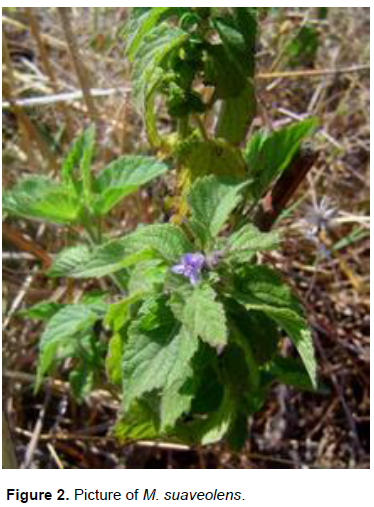
State of the occurrence data of M. suaveolens
In order to achieve the state of occurrence data of M. suaveolens we took into account three main points:
1) Downloading data from the Global Biodiversity Information Facility database (GBIF);
2) Occurrence data from literature and
3) Field data collection.
The data obtained were analyzed and subjected to a whole cleaning process using Excel and OpenRefine software (version 2.6, Chan Zuckerberg Initiative, 2010). With the help of these softwares, the check of scientific names was carried out and duplicated data were discarded. Successive filters made it possible to retain the data corresponding to the current climate (occurrences collected in the time range from 1960 to the present day).
Verification of geographic coordinates was then carried out. Indeed, the coordinates were displayed in the cartographic software QGIS (version 2.18.4; Tim Sutton, 2016) and superimposed on the vector data of the boundaries of Africa in order to verify their ranges.
Description of the impacts of M. suaveolens on biodiversity in Benin
Data concerning the impact of M. suaveolens were collected from populations facing problems caused by the species; we therefore envisioned to understand and appreciate their knowledge. To this end, a questionnaire was sent to the respondents. The description of the different impacts of M. suaveolens cited by the populations was collected. The target groups surveyed were mainly livestock breeders and farmers, who are confronted to the damages of this species. The sampling of the people to be surveyed was based on the reported presence of the species through the geographical coordinates downloaded from the GBIF website (www.gbif.org) and on the localities where the species has been reported in the flora of Benin (De Souza, 2009). The juxtaposition of these data made it possible to target three communes per climatic zone in Benin in order to cover different areas of the territory while taking into account the species presence criterion. The selected localities were the following municipalities: Djougou, Natitingou and Kouandé in the Sudanian zone (Zone I); Dassa-Zoumè, Savè and Glazoué in the Sudano-Guinean zone (Zone II); Zogbodomè, Bohicon and Zè in the Guinean zone (Zone III). The sample size was determined using Dagnelie's formula (Dagnelie, 1998) and using statistics from the national census (RGPH4).

With n: the number of respondents; U: Value of the confidence level of a normal distribution; p: the proportion of the agricultural population in relation to the total population; d: the margin of error set at 7% for this study.
Ecological niche modelling of M. suaveolens
The modelling was done in the Maxent software (Phillips, 2006), one of the best frequently cited in the literature (Phillips, 2006) using present and future climate variables downloaded from the Africlim website at a resolution of 2.5 min under the rcp4.5 and rcp8.5 scenarios at horizon 2055 (Platts, 2015). A mask has been created to cover the points of occurrence. This is the area of accessibility or presence (P) of the species in the sense of Soberón and Peterson (2005). The environmental variables of the present and future downloaded were carefully cut out according to the mask and then converted into ASCII format using the mapping software QGIS (version 2.18.4; Tim Sutton, 2016). Part of the occurrence data (75%) was used to calibrate the model, the second part to test it. A selection of appropriate environmental variables was then made to determine the environmental variables that most govern the distribution of the species.
Strategies for the control and eradication of M. suaveolens in the context of climate and global changes
The fight against invasive species requires the elaboration of laws and regulations to limit their introduction and expansion, but also and above all the establishment of a strategy and management tools to control and even eradicate them. Based on the results of modelling, surveys carried out and previous work on the species, effective control and eradication strategies in the context of climate and global changes were deduced and proposed.
State of the occurrence data of M. suaveolens
M. suaveolens is a species widely distributed in the world, found in Africa south of the Sahara. It is present in Benin and has a wide distribution. The collection of occurrence data through the Global Biodiversity Information Facility (GBIF); the data collected in the field and data obtained through literature has enabled us to have a total of 2900 occurrences of which, 2065 from GBIF, 22 from literature and 813 from field collection (Figure 3). The points of occurrence of this species are distributed over Africa south of the Sahara, mainly West and East Africa. In Benin, this species is geographically distributed along the territory and affects all the departments.
Description of the socio-economic and environmental impacts of M. suaveolens in Benin
M. suaveolens commonly known as "Zansoukpè man" in “Fongbé’’, a local language of Benin, is recognized by respondents as an invasive alien species causing enormous damage. Respondents unanimously agreed that M. suaveolens is not eaten by ruminants and its heavy presence and expansion considerably reduces forage resources. The species is reported to be the cause of several weeding in fields and fallows, increasing the cost of production. The spread of the species has been attributed to various factors. Wind, runoff and accidental transport were the most frequently cited factors. In fact, 30.29% of the respondents considered wind to be the most important factor in the spread of the species.
However, 20.44% believe that the spread of the species is induced by runoff water. On the other hand, 18.22% of the respondents believe that the spread is by accidental transport. However, concerning a possible use of the plant, a proportion of 24.87% of the participants cited medicinal virtues notably against wounds, fever and as a repellent to fight against mosquitoes.
Ecological niche model of M. suaveolens
Selection of environmental variables
A total of 4 bioclimatic variables were selected. These are: bio4 (Temperature Seasonality), bio6 (Minimum Temperature of Coldest Month), bio12 (Annual Precipitation) and bio 17 (Precipitation of Driest Quarter). The importance of these variables was also assessed using the jackknife test, whose analysis showed that the variables that contributed most to the development of the model when used in isolation were, in order of importance: bio12, bio17, bio4 and bio6 (Figure 4). For each environmental variable, the green bar shows how much the total gain is reduced if that specific variable is excluded from the analysis, while the blue bar shows the gain if a variable if used solely in the analysis. The value of the Area Under Curve (AUC) from the implementation of the Maxent model (0.790) (Figure 5) confirmed the good performance of the Maxent algorithm in capturing variations in the environmental data. The TSS value was 0.47 and the Partial ROC test indicated that the model performed better than random.
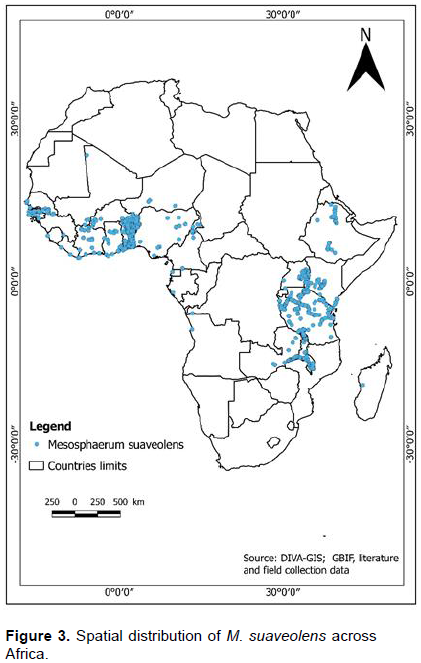
Current and future distribution of M. suaveolens habitats
The modelling results showed that Africa south of Sahara is globally threatened by the species with the exception of part of southern Africa (Figure 6). For the future projections to 2055, the model predicted a considerable increase in the current ranges of the species. It appeared that climate change will lead to an increase in the current ranges of M. suaveolens. The standard deviation map help to understand uncertainties related to the projections. Indeed, we globally have zero as the value of uncertainties except in Central Africa, East Madagascar and South of South Africa where the value of uncertainty is about 0.25 (Figures 7 and 8). With the standard deviation map (Figure 9), we observed limited uncertainties, which indicated a reliable model prediction. However we notice 0.25 as uncertainties value in south of West Africa (Figure 10). For the scenario RCP 4.5, the standard deviation map also indicate generally limited uncertainties except at the north of the East Africa (Figure 11).
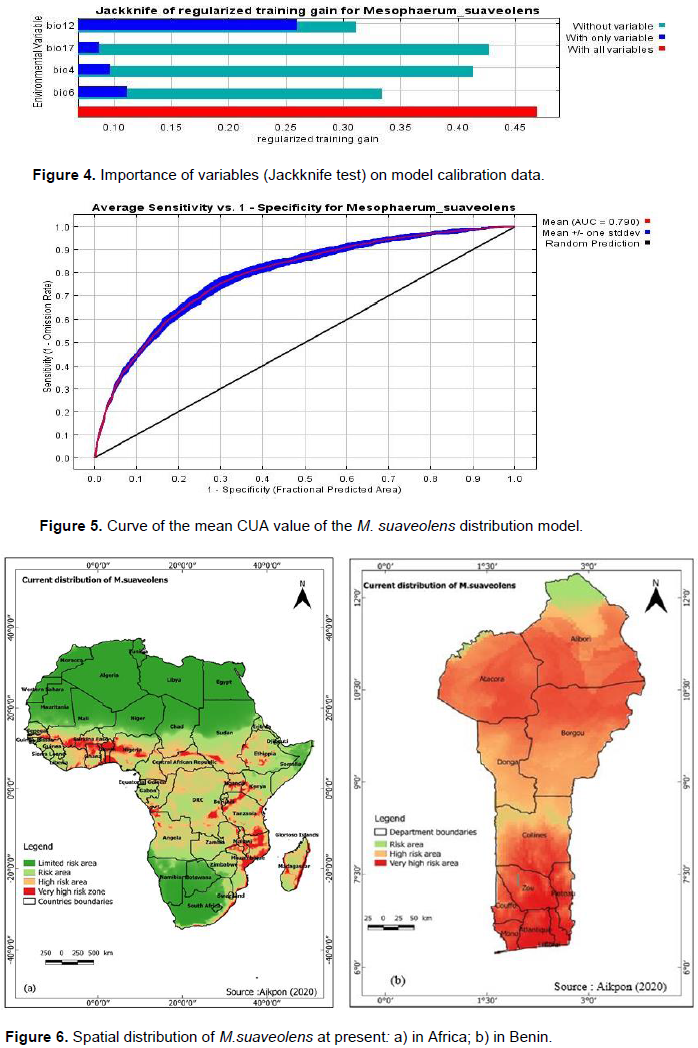
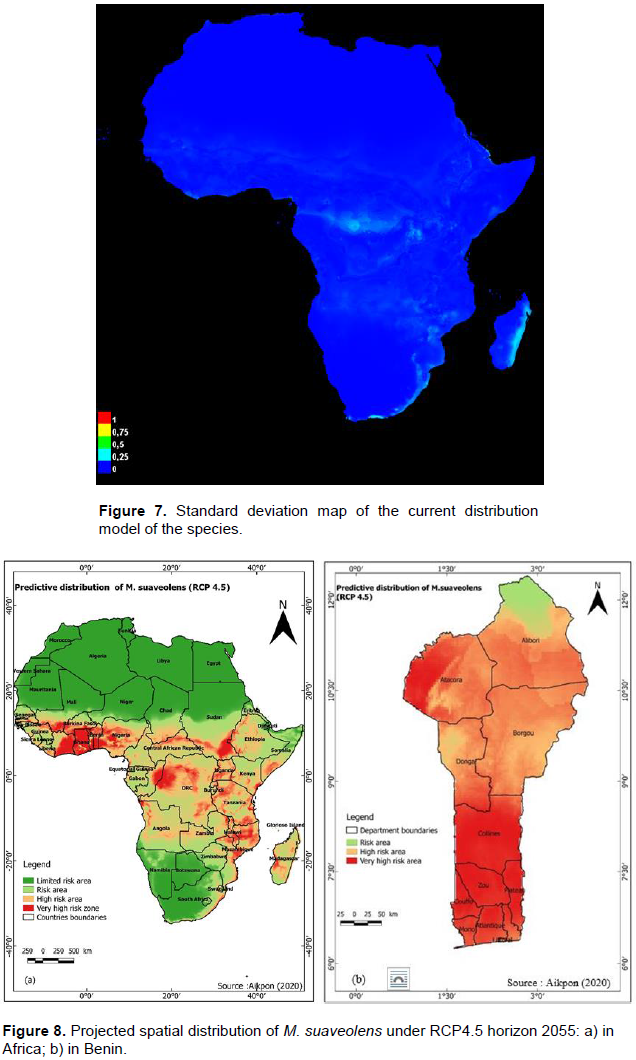
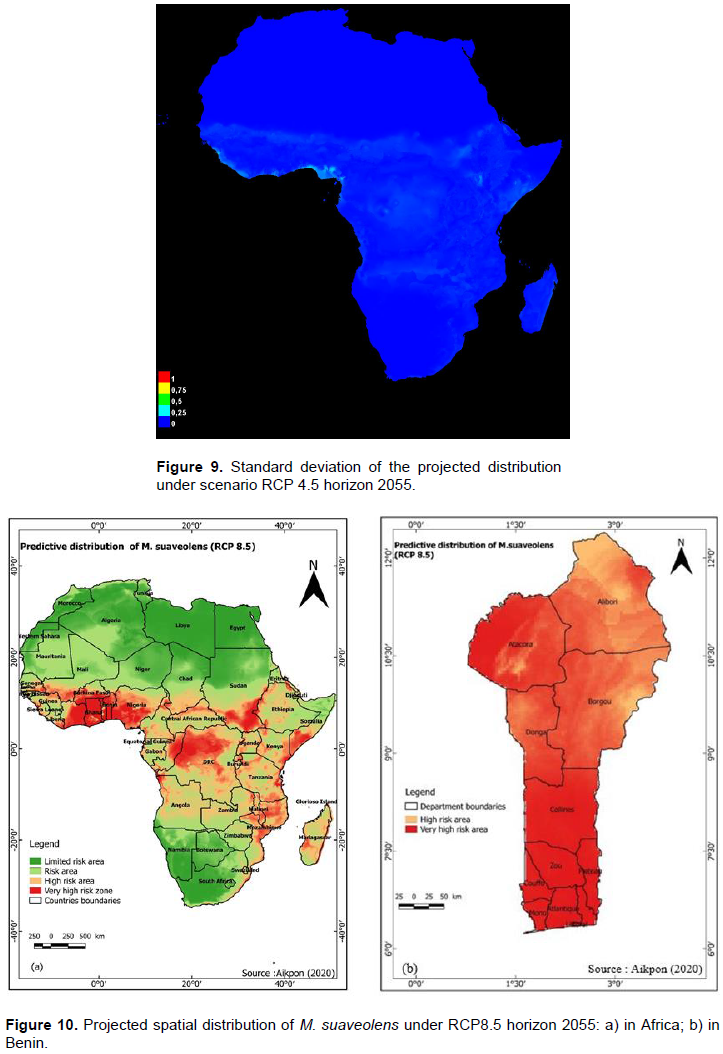

Socio-economic and environmental risks of the invasion of alien species in general and of M. suaveolens in particular in Benin and Africa
The present study highlights the problem of invasive alien plants in general and that of M. suaveolens in particular. Spreading of alien species cause biodiversity degradation and have important socioeconomic and ecological impacts (Duguma et al., 2019).The results of the surveys confirmed that the invasion of M. suaveolens represents a serious threat to agricultural and pastoral activities as well as to native biodiversity. Indeed, this plant has an adverse impact on the vegetation of invaded areas in terms of reduction of number of species and diversity (Oumorou et al., 2010). It establishes and develops to the detriment of native species, whose germination is considerably hindered, thus leading to the scarcity of native species. In fields and fallows, it causes a series of repetitive maintenance operations, thus increasing production costs. Furthermore, it considerably reduces the plant biomass available for consumption in pastures. Since the invasive plant is not palatable, cattle, through selective grazing, exert a strong pressure on grasses and other palatable resources.
The economic and social impacts of invasive species in general and of M.suaveolens in particular include both directed effects on agricultural productivity, public utility operations, tourism and outdoor recreation, as well as costs associated with control efforts that this species generates (Leistritz et al., 2004). Indeed, M. suaveolens is responsible for significant maintenance costs for crop fields, which contributes to the increase in food costs for certain producers. Also, the presence of this species in cities and agglomerations makes maintenance costs while having a negative effect on tourism activities (U.S. Fish and Wildlife Service, 2012).For example, "a study has estimated that the economic damage associated with invasive species in the United States is approximately $ 120 billion per year" (U.S. Fish and Wildlife Service, 2012).
Ecology of M. suaveolens and environmental factors governing its distribution
The results of the field work revealed that M. suaveolens grows in fallows, pastures, unmanaged plots, and alongside roads. It also infests ploughed land and grows less under woody areas. It adapts to several types of soil, prefers open, well-drained environments and shows a great ecological amplitude. The results of our model are consistent with the ecology of the species. In fact, annual precipitation (bio12), temperature and its seasonality (bio4) are among the variables that contributed most to the species distribution prediction models. The distribution of this species is also influenced by several environmental factors (Sharma et al., 2017). Indeed, the destruction of natural ecosystems and poor land use leave a free field for the establishment of this species and contribute greatly to its expansion. Strong air currents, run-off water and various human activities (transport, etc.) all contribute to the species dispersal.
Impact of climate and global change on the distribution of M. suaveolens
Since climate is one of the main determinants of plant distribution, climate change influences plant expansion (McNeely et al., 2001). The coming decades will be more marked by global changes, which will have major impacts on ecosystems and biological invasions (National Research Council, 1989). Indeed climate change and proliferation of invasive species are now considered as two very important factors acting on global biodiversity change (Taylor et al., 2014). Ecological niche modeling to understand and predict the impact of climate change on species depends a lot on environmental factors (Ganglo et al., 2017). Climate change modifies two of the main factors that control the distribution of biomes: temperature and precipitation. This means that the ecosystems found within the biomes are directly affected by climate change. The results of our work clearly showed an expansion of areas at risk for M. suaveolens under any scenario considered. This species, already widely distributed in Benin and sub-Saharan Africa with the exception of part of southern Africa, will expand under the influence of climate change. These results obtained corroborate those of other research work carried out in the field. Indeed, invasive species are benefiting from climate change (IUCN, 2000). When the climate varies rapidly, invasive plant species, which are more adaptable, far better than other species, increase their pressure on ecosystems (Peterson et al., 2003). Their threat is therefore bound to increase, both for biodiversity and for human activities.
Species control and eradication strategies
The proliferation of M. suaveolens is a major problem today. In particular, its proliferation is a major pastoral problem for pastoralists, disrupting farmers and having a negative impact on ecosystems and native biodiversity. It is important and capital that management actions are and undertaken to save rangelands, biodiversity in general to relieve farmers. It is therefore imperative to regularly raise public awareness on the danger that this species presents to biodiversity and its long-term impact. Raising awareness and regularly sensitizing populations is very important in invasive species control (Natukunda et al., 2019). It is also imperative to develop programs and activities to combat this species; to involve the population in decision-making and in the development of programs of activities to combat this species; and to intensify awareness-raising sessions on good land-use practices for the population; to train the populations in techniques for monitoring, cutting, bark removing and eradication of this species from their fields and surrounding environments; to introduce monitoring and targeted actions; to implement biological control measures aimed at protecting natural ecosystems, a refuge of great diversity, as a matter of priority. Biological control is the long-term, less costly and environmentally friendly solution. Several authors have suggested the use of competitive species such as perennial grasses to control invasive herbaceous species (D'Antonio and Meyerson, 2002).
In addition to the statements made by some respondents about the mosquito control properties of this species, studies have shown its insecticidal effect. We also suggest working towards the implementation of well-developed plans to induce large-scale use of this species. This will not only reduce the density of this species but will also be profitable. The implementation and evaluation of different methods are essential on invasive species control (da Silveira et al., 2018).
This study found that, consistent with its ecology, the spatial distribution of M. suaveolens is primarily controlled by precipitation and temperature variables (seasonality of temperature, minimum temperature of the coldest month, annual precipitation, and precipitation of the driest quarter). Our study also demonstrated that the invasion of M. suaveolens has a significant adverse impact on biodiversity, which in turn affects the local populations that depend on this biodiversity. The species induces a negative impact in terms of reduction in species numbers, diversity, richness and uniformity. As a result, the species has socio-economic implications for local populations such as depleted grazing for livestock and the loss of major plant species used by local people. It is therefore urgent that more efforts be made to manage this species. For future investigations, it will be useful to focus on the propagation mechanism, the quantification of socio-economic implications and the best possible values of this species in order to control it effectively.
The authors have not declared any conflict of interests.
The authors express their gratitude to JSR Biodiversity Foundation for its financial support to the master program of biodiversity informatics in Benin and also thank Professor Peterson Town of the University of Kansas (USA) very much for his dedicated role of adviser of the master program of biodiversity informatics.
REFERENCES
|
Aboh AB (2008). Phytosociologie, écologie, potentialités et aménagement des pâturages naturels envahis par Chromolaena odorata et Hyptis suaveolens en Zone Soudano-guinéenne (Bénin). University of Abomey-Calavi.
|
|
|
|
Akoègninou A, Van der Burg, Joost W, van der Maesen (2006). Flore analytique du Bénin (No. 06.2). Backhuys Publishers.
|
|
|
|
|
D'Antonio C, Dudley TL, Mack MC (1999). Disturbance and biological invasions: direct effects and feedbacks. In: L. Walker (eds.), Ecosystems of disturbed ground. Elsevier, Amsterdam pp. 413-452.
|
|
|
|
|
D'Antonio C, Meyerson LA (2002). Exotic Plant Species as Problems and Solutions in Ecological Restoration: A Synthesis. Restoration ecology 10(4):703-713.
Crossref
|
|
|
|
|
da Silveira LP, Piuzana D, Pereira IM, Lafetá BO, dos Santos JB (2018). Evaluation of different methods to control invasive alien grass weeds in a degraded area. African Journal of Agricultural Research 13(32):1655-1660.
Crossref
|
|
|
|
|
Dagnelie P (1998). Stastique théorique et appliqué (Tome2). Available At:
View
|
|
|
|
|
De Souza SG (2009). Flore du Benin.
View
|
|
|
|
|
Dharam PA, Uma S (2012). Integrated Pest Management: Principles and Practice. CABI.
|
|
|
|
|
Duguma G, Fitamo D, Kebede F (2019). Socioeconomic and ecological consequences of Parthenium weed (Parthenium hysterophorus L.) in Boset Woreda, Ethiopia. African Journal of Agricultural Research 14(34)1921-1942.
Crossref
|
|
|
|
|
Fandohan AB (2015). Modeling vulnerability of protected areas to invasion by Chromolaena odorata under current and future climates. Ecosystem Health and Sustainability 1(6):1-12.
Crossref
|
|
|
|
|
Ganglo JC, Djotan GK, Gbètoho JA, Kakpo SB, Aoudji AKN, Koura K, Tessi DRY (2017). Ecological niche modeling and strategies for the conservation of Dialium guineense Willd. (Black velvet) in West Africa. International Journal of Biodiversity and Conservation 9(12):373-388.
Crossref
|
|
|
|
|
Hobbs R, Huenneke LF (1992). Disturbance, Diversity, and Invasion: Implications for Conservation. Conservation Biology 6(3):324-337.
Crossref
|
|
|
|
|
Hutchinson J, Dalziel (1963). Flora of West Africa.
Crossref
|
|
|
|
|
International Union for Conservation of Nature (IUCN) (2000). Guidelines for the Prevention of Biodiversity Loss Caused by Alien Invasive Species.
View
|
|
|
|
|
International Union for Conservation of Nature (IUCN) (2004). A global species assessment.
View
|
|
|
|
|
Leistritz FL, Bangsund DA, Hodur NM (2004). Assessing the economic impact of invasive weeds: The case of leafy spurge (Euphorbia esula). Weed Technology 18(sp1):1392-1395.
Crossref
|
|
|
|
|
Lozon JD, Maclsaac HJ (1997). Biological invasions: are they dependent on disturbance? Environmental Reviews 5(2):131-144.
Crossref
|
|
|
|
|
Mack R, Simberloff ND, Lonsdale WM, Evans H, Clout M, Bazzaz FA (2000). Biotic invasions: Causes, epidemiology, global consequences, and control. Ecological Applications 10:689-710.
Crossref
|
|
|
|
|
Mazza G (2014). Biological invaders are threats to human health: An overview. Ethology Ecology & Evolution 26(2-3):112-129.
Crossref
|
|
|
|
|
McNeely, Mooney HA, Neville LE, Schei P, Waage JK, (eds.) (2001). A Global Strategy on Invasive Alien Species.
|
|
|
|
|
Millennium Ecosystem Assessment (2005).
View
|
|
|
|
|
National Research Council (1989). Division on Engineering and Physical Sciences, Commission on Physical Sciences, Mathematics, and Applications, Commitee on Global Change. Global Change and Our Common Future: Papers from a Forum.
|
|
|
|
|
Natukunda MI, Natukunda K, Kyeyune G, Tusiime SM, Agbemafle I, Bisikwa J (2019). Management strategies for the noxious invasive parthenium weed (Parthenium hysterophorus L.) in Uganda. African Journal of Agricultural Research 15(1):1-9.
Crossref
|
|
|
|
|
Oumorou M, Aboh BA, Babatounde S, Houinato M, Sinsin B (2010). Pastoral value, productivity and endogenous knowledge of the effect of the invasion, by Hyptis suaveolens L. Poit., of natural pastures in the Sudano-Guinean zone (Benin). International Journal of Biological and Chemical Sciences 4(4).
Crossref
|
|
|
|
|
Peterson AT, Papes M, Kluza DA (2003). Predicting the potential invasive distributions of four alien plant species in North America. Weed Science 51(6):863-868.
Crossref
|
|
|
|
|
Phillips SJ (2006). Maximum entropy modeling of species geographic distributions. Ecological modeling 190(3-4):231-259.
Crossref
|
|
|
|
|
Pimentel D, Zuniga R, Morrison D (2005). Update on the environmental and economic costs associated with alien-invasive species in the United States. Ecological Economics 52(3):273-288.
Crossref
|
|
|
|
|
Platts PJ (2015). AFRICLIM: high?resolution climate projections for ecological applications in Africa. African Journal of Ecology pp. 103-108.
Crossref
|
|
|
|
|
Pôle-Relais Lagunes Méditerranéennes (2017). Les espèces exotiques envahissantes en milieux humides, version 2017. Pôles-relais zones humides P 56.
|
|
|
|
|
Raizada P (2006). "Ecological and Vegetative Characteristics of a Potent Invader, Hyptis suaveolens (L.) Poit. from India." Lyonia 11:115-120.
|
|
|
|
|
Sachs JD, Baillie EM, Sutherland WJ, Armsworth PR, Ash N, Beddington J (2009). Biodiversity Conservation and the Millennium Development Goals. Science 325(5947):1502-1503.
Crossref
|
|
|
|
|
Simberloff D, Martin JL, Genovesi P, Maris V, Wardle D, Aronson J, Courchamp F, Galil B, Garcia-Berthou E, Pascal M, Pysek P, Sousa R, Tabacchi E, Vilà M(2019). Impacts of Biological Invasions. Bulletin of the Ecological Society of America 100(4):1-9.
|
|
|
|
|
Vitousek PM (1988). Diversity and biological invasion on oceanic islands. In: Wilson E.O. & Peter F.M. (eds.), Biodiversity pp. 181-189.
|
|
|
|
|
Wilcove DS, Rothstein D, Dubow J, Philips A, Losos E (1998). Quantifying threats to imperilled species in the United States. BioScience 48:60-615.
Crossref
|
|
|
|
|
Soberón J, Peterson AT (2005). Interpretation of Models of Fundamental Ecological Niches and Species' Distributional Areas. Biodiversity Informatics 2:1-10.
Crossref
|
|
|
|
|
U.S. Fish & Wildlife Service (2012). The cost of invasive species.
View
|
|